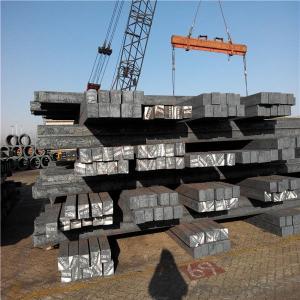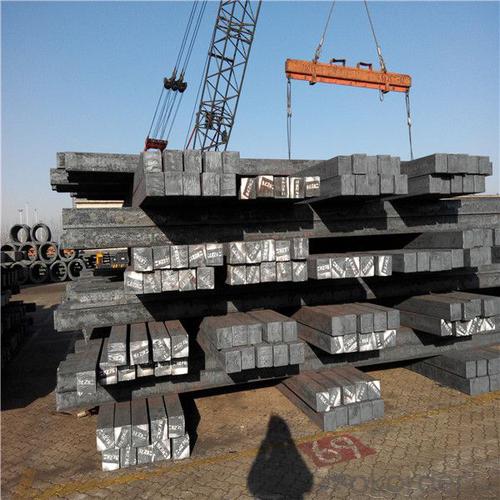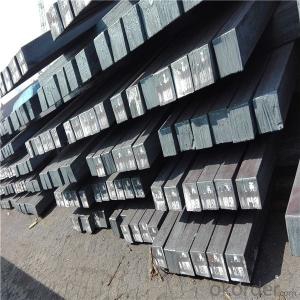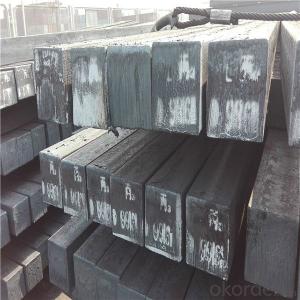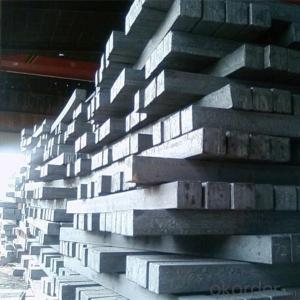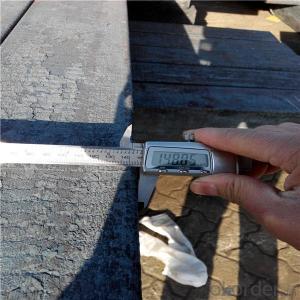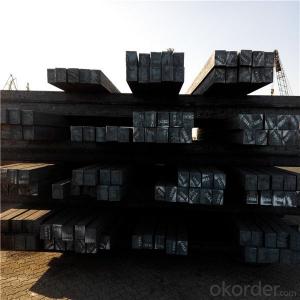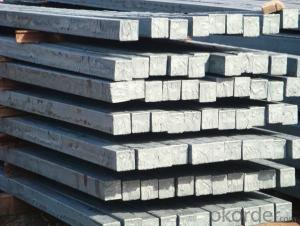China steel billets good price Q195 Q215 Q235 Q275
- Loading Port:
- China main port
- Payment Terms:
- TT OR LC
- Min Order Qty:
- 1000 m.t.
- Supply Capability:
- 17142 m.t./month
OKorder Service Pledge
OKorder Financial Service
You Might Also Like
Specification
Billets, or ingots (as they sometimes referred to), are not of practical use until they have been formed
into more functional shapes and sizes. While they have already been put in the furnace, they still require
a series of shaping and molding procedures such as hot and cold working, milling and cutting before they
are sold in hardware stores, or used for different applications. The unformed billets, however, can be used
in striking currency such as coins and as reserves, similar to gold bars.
Steel billets have distinct characteristics as compared with already furnished steel bars and products. Billets
have a specific grain structure, which enables the metal to be processed more intricately. Steel billets are also
known for their malleability and ductility, especially when exposed to varying temperatures during shaping and molding.
Gade:
Standard | C(%) | Mn(%) | S(%) | P(%) | Si(%) |
Q195 | ≤0.12 | ≤0.50 | ≤0.040 | ≤0.035 | ≤0.30 |
Q235 | ≤0.20 | ≤1.40 | ≤0.045 | ≤0.045 | ≤0.35 |
Q275 | ≤0.22 | ≤1.50 | ≤0.045 | ≤0.045 | ≤0.35 |
20MnSi | 0.17-0.25 | 1.2-1.6 | ≤ 0.050 | ≤ 0.050 | 0.40-0.80 |
3SP | 0.14-0.22 | 0.40-0.85 | ≤ 0.050 | ≤ 0.040 | 0.05-0.15 |
5SP | 0.28-0.37 | 0.50-1.00 | ≤ 0.050 | ≤ 0.040 | 0.15-0.30 |


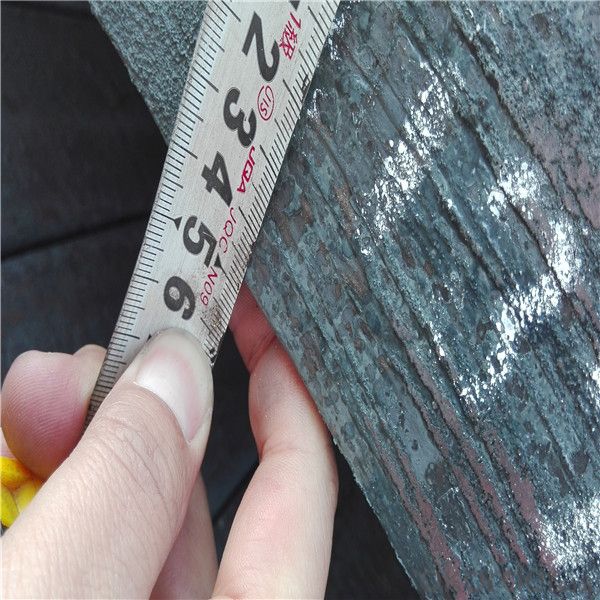
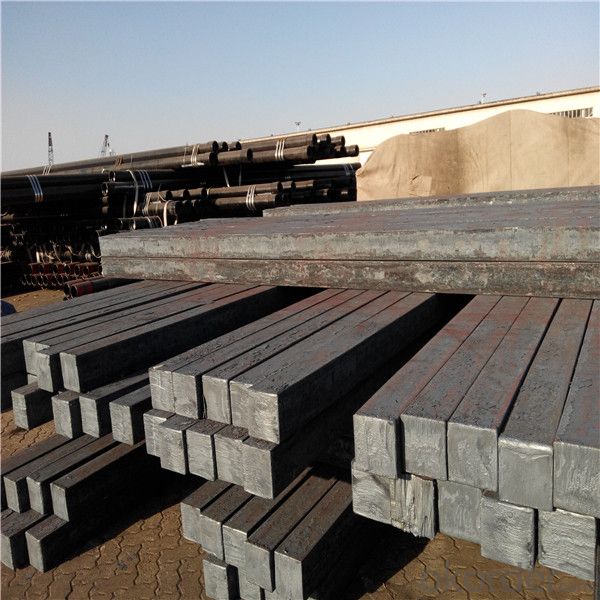
Other Specifications
Squar Tolerance: ±4
Length Tolerance: +100mm
Romboidity/Difference Diagonals: no more than 0.7%
Camber: no more than 1.5%(%)
Twist: no more than 3 degrees per 1 meter length
Our Advantage
* Professional Personnel of Steel Trading
* Strong Steel Industry Background
* Conveniently Geographic Location
Our Commitment
* Sincere, Practical, Efficient and Developing
* High Quality Steel Production
* Competitive Price and Timely Delivery
Packing :
Within 30 days
1.Standard export package
2.In bundles with steel strips
3.As the requirements of the customers
FAQ:
Q: How to get quotation?
A: When we receive your detailed enquiry, we will set the best price based on standard,
steel grade, outer diameter, wall thickness, quantity, country.
And we will send quotation to your mailbox.
Q:How to guarantee the quality of the products?
A:We have established the international advanced quality management system,every link from raw material
to final product we have strict quality test;We resolutely put an end to unqualified products flowing into the market.
At the same time, we will provide necessary follow-up service assurance.
Q:How long can we receive the product after purchase?
A :In the purchase of product within three working days, We will arrange the factory delivery as soon as possible.
The pecific time of receiving is related to the state and position of customers.
- Q: What is the difference between steel billets and steel ingots?
- Steel billets and steel ingots are both intermediate forms of steel used in the manufacturing process, but they differ in terms of their shape and size. Steel billets are smaller, square or round-shaped solid bars, typically measuring around 2 to 7 inches in diameter, and are produced through continuous casting or hot rolling processes. On the other hand, steel ingots are larger, rectangular or cylindrical-shaped blocks, with dimensions ranging from a few inches to several feet, and are usually produced through the traditional casting method. The main distinction lies in their size and shape, with billets being smaller and more manageable for further processing, while ingots are larger and require additional steps, such as forging or rolling, to be transformed into usable steel products.
- Q: How do steel billets contribute to the overall cost-effectiveness of a structure?
- The overall cost-effectiveness of a structure is greatly enhanced by the use of steel billets in multiple ways. Firstly, the manufacturing process of steel billets is highly efficient, resulting in minimal wastage of raw materials. This efficiency significantly reduces the production cost of steel billets, making them a cost-effective option for construction projects. Furthermore, steel billets possess exceptional strength and durability, enabling them to withstand heavy loads and adverse weather conditions. This strength eliminates the need for frequent repairs or replacements, saving significant costs in the long term. Additionally, the durability of steel billets ensures the longevity of the structure, reducing maintenance expenses and enhancing cost-effectiveness. Another significant aspect of steel billets that contributes to cost-effectiveness is their versatility. They can be easily molded and shaped into various forms, allowing for customization and precise engineering in constructing the structure. This versatility eliminates the need for excessive material wastage and enables the optimization of resources, thereby reducing costs. Moreover, steel billets have excellent fire resistance properties, making them a safe and reliable choice for structures. By minimizing the risk of fire-related damages, steel billets contribute to reduced insurance costs for the structure, enhancing its overall cost-effectiveness. Lastly, steel billets are often produced using recycled steel, which not only reduces the environmental impact but also lowers the production cost. This eco-friendly aspect further enhances the cost-effectiveness of a structure by reducing the overall carbon footprint and making it more sustainable in the long term. In conclusion, the cost-effectiveness of a structure is improved through the use of steel billets by minimizing material wastage, providing strength and durability, offering versatility in design and engineering, ensuring fire resistance, and promoting sustainability. These factors collectively reduce production, maintenance, repair, and insurance costs, making steel billets a financially beneficial choice for construction projects.
- Q: What are the different surface treatments for improved surface lubrication in steel billets?
- To enhance surface lubrication, there are multiple techniques available for treating steel billets. These treatments target the reduction of friction and wear during manufacturing processes like rolling or extrusion. Some commonly used methods to improve surface lubrication in steel billets are: 1. Phosphating: By applying a phosphate coating to the steel surface, this treatment creates a thin layer of phosphate compound. Acting as a lubricant, it minimizes friction between the billet and machinery during processing. 2. Nitriding: Through the introduction of nitrogen into the steel surface, nitriding forms a nitride layer. This layer enhances the billet's surface hardness, wear resistance, and lubrication properties, reducing friction. 3. Electroplating: This treatment involves depositing a layer of metal, such as zinc or nickel, onto the surface of the steel billet. Besides improving lubrication, it also offers corrosion protection, extending the billet's lifespan. 4. Surface coating: Different types of coatings, such as Teflon or polymer-based coatings, can be applied to steel billets. These coatings create a low-friction surface, preventing sticking or galling during processing. 5. Shot peening: Shot peening is a mechanical surface treatment that bombards the steel surface with small, high-velocity metal shots. This process induces compressive stress in the surface layer, enhancing wear resistance and reducing friction. 6. Case hardening: Case hardening involves the diffusion of carbon or other alloying elements into the steel surface through heat treatment. This treatment forms a hardened outer layer, improving lubrication properties and reducing friction during processing. In summary, these surface treatments offer advantages such as reduced wear, improved efficiency, and extended tool life for steel billets. The choice of treatment depends on specific application requirements and the desired properties of the billet.
- Q: What are the common surface defects in steel billets?
- Some common surface defects that can be found in steel billets include: 1. Scale: This is a thin layer of oxide that forms on the surface of the billet during the hot rolling process. It can appear as a flaky or rough texture and is caused by the reaction of the steel with oxygen in the air. 2. Cracks: Cracks can occur due to a variety of reasons, such as improper cooling or excessive stresses during the manufacturing process. These cracks can be either longitudinal or transverse and can greatly affect the structural integrity of the billet. 3. Pitting: Pitting refers to small depressions or cavities that can form on the surface of the billet. It is often caused by localized corrosion or reactions with impurities in the steel. 4. Lamination: Lamination defects occur when there are layers or sheets of non-metallic inclusions within the steel billet. These inclusions can weaken the billet and affect its mechanical properties. 5. Surface porosity: Surface porosity refers to the presence of small voids or bubbles on the surface of the billet. It can be caused by gas entrapment during the solidification process or by improper casting techniques. 6. Inclusions: Inclusions are non-metallic substances that can be present in the steel billet. These can include oxides, sulfides, or other impurities, and can affect the billet's mechanical properties. It is important to identify and address these surface defects in steel billets as they can impact the quality and performance of the final product. Various inspection techniques, such as visual inspection, ultrasonic testing, or magnetic particle testing, can be employed to detect and eliminate these defects to ensure the production of high-quality steel products.
- Q: What are the key properties and characteristics of steel billets?
- Steel billets, which have a rectangular shape and typically a square cross-section, are semi-finished steel products. They serve as the initial stage for manufacturing various steel products such as bars, rods, and wire. Steel billets possess several important properties and characteristics: 1. Composition: Steel billets primarily consist of iron and carbon, with additional alloying elements incorporated to enhance specific properties. The carbon content generally ranges from 0.2% to 0.5%, depending on the desired strength and hardness. 2. Strength and Hardness: Due to their composition and heat treatment processes, steel billets offer excellent strength and hardness. This makes them suitable for applications requiring high load-bearing capacity and resistance to wear and tear. 3. Ductility: Despite their strength, steel billets also exhibit good ductility, allowing them to be easily shaped and formed into various products through processes like rolling, extrusion, and forging. This versatility enables their use in different manufacturing methods. 4. Homogeneity: Steel billets possess a uniform internal structure, ensuring consistent mechanical properties throughout the entire material. This homogeneity is achieved through precise casting and cooling processes, which minimize the presence of defects and impurities. 5. Dimensional Precision: Steel billets are manufactured with specific dimensions and tolerances, ensuring the desired size and shape for downstream processing. This dimensional precision enables efficient and accurate production, minimizing waste and maximizing productivity. 6. Surface Quality: Steel billets have a smooth and clean surface finish, free from significant imperfections or irregularities. This is crucial for subsequent processing steps, as it ensures proper bonding during welding, machining, or coating operations. 7. Heat Conductivity: Steel billets exhibit excellent thermal conductivity, efficiently transferring heat during various manufacturing processes like hot rolling or continuous casting. This property ensures uniform heating and cooling, resulting in consistent material properties. 8. Corrosion Resistance: Steel billets are prone to corrosion if left unprotected. However, they can be coated or treated with anti-corrosive measures to enhance their resistance to rust and other forms of degradation. In summary, steel billets are characterized by their strength, ductility, dimensional precision, and homogeneity. These properties make them a critical raw material in the steel industry, facilitating the production of high-quality steel products used in diverse sectors such as construction, automotive, and infrastructure.
- Q: How are steel billets used in the manufacturing of industrial valves?
- Steel billets are used in the manufacturing of industrial valves as they serve as the raw material for forging and shaping various valve components, such as the body, bonnet, and stem. These billets are heated, and through a process called hot forging, they are transformed into the desired shape and size of the valve parts. The use of steel billets ensures the strength, durability, and integrity of the valves, making them suitable for demanding industrial applications.
- Q: How are steel billets used in the manufacturing of consumer goods?
- Steel billets are a crucial raw material used in the manufacturing of consumer goods. These billets are primarily utilized as feedstock in various metalworking processes such as hot rolling, forging, and extrusion. By shaping and forming the steel billets into desired shapes, manufacturers are able to produce a wide range of consumer goods like automobiles, appliances, construction materials, and machinery components. The high strength and durability of steel make it an ideal choice for consumer goods, ensuring reliability and longevity in the final products.
- Q: What are the market trends and growth prospects for steel billets?
- Steel billets play a vital role in the steel industry as they serve as the primary material for various downstream applications. The growth and market trends of steel billets are greatly influenced by factors like global economic growth, infrastructure development, and the demand for steel in different sectors. One notable market trend for steel billets is the increasing demand from the construction industry. With the rapid urbanization and infrastructure development in emerging economies, there is a rising need for steel-intensive construction projects. Steel billets are extensively used in the construction of bridges, buildings, and other infrastructure projects, which drives the demand for this product. Another market trend is the growing demand for steel billets in the automotive industry. The automotive sector is a major consumer of steel, and as the industry shifts towards lightweight and high-strength materials, the demand for steel billets is expected to increase. Steel billets are used in the production of various automotive components, including engine parts, chassis, and suspension systems. Furthermore, the increasing focus on renewable energy sources such as wind and solar power is expected to drive the demand for steel billets. Steel components are required for wind turbines and solar panel structures, and as renewable energy projects expand globally, the demand for steel billets is likely to experience significant growth. In terms of growth prospects, the steel billets market is expected to witness steady growth in the coming years. The Asia-Pacific region, particularly China and India, is projected to dominate the market due to their robust construction and infrastructure sectors. These countries have extensive urbanization projects and ongoing infrastructure development plans, which will contribute to the demand for steel billets. Additionally, the recovery of the global economy after the COVID-19 pandemic is expected to boost the demand for steel billets. As economies bounce back and industrial activities regain momentum, the demand for steel in various sectors, including construction, automotive, and energy, will increase, positively impacting the steel billets market. However, it is important to note that market trends and growth prospects for steel billets can be influenced by factors like fluctuations in raw material prices, trade policies, and environmental regulations. Furthermore, the increasing adoption of alternative materials such as aluminum and composites in certain applications may pose a challenge to the growth of the steel billets market. In conclusion, the market trends for steel billets are driven by the demand from the construction, automotive, and renewable energy sectors. The growth prospects for this market are promising, particularly in the Asia-Pacific region as economies recover from the pandemic and infrastructure projects gain momentum. Nevertheless, challenges such as fluctuations in raw material prices and competition from alternative materials should also be taken into consideration.
- Q: What is the role of steel billets in the construction of bridges?
- The construction of bridges relies heavily on steel billets, which are essential for the production of various structural components. These rectangular bars of steel serve as raw material and are transformed into beams, girders, and reinforcement bars. Beams and girders are fabricated from steel billets and are crucial for providing support and load-bearing capacity to bridges. By heating and rolling the billets into the desired shape, these structural elements are created and then welded or bolted together to form the bridge's framework. In addition, steel billets are used to produce reinforcement bars, also known as rebar, which are vital for giving tensile strength to concrete structures like bridge foundations, piers, and abutments. By reinforcing the concrete with steel billets in the form of rebar, bridges can withstand the forces exerted by heavy traffic, wind, and other external factors. There are several advantages to using steel billets in bridge construction. Firstly, steel is known for its outstanding strength and high strength-to-weight ratio, making it an ideal material for bridges. Steel billets can bear heavy loads and provide the necessary structural integrity, ensuring the longevity and durability of the bridge. Furthermore, steel exhibits excellent resistance to corrosion, which is crucial for bridges exposed to harsh weather conditions and environmental factors. Corrosion can weaken a bridge's structure and compromise its safety and longevity. However, by using steel billets that can be coated or galvanized to enhance corrosion resistance, bridges can maintain their structural integrity over a prolonged period. To summarize, steel billets play a vital role in bridge construction by fabricating beams, girders, and rebar. They provide the necessary strength, support, and durability to withstand heavy loads and external forces. Steel billets contribute significantly to the overall safety, longevity, and functionality of bridges, making them an indispensable component in bridge construction.
- Q: How are steel billets used in the production of beams and columns?
- Beams and columns require steel billets, which are semi-finished steel products typically in square or rectangular shapes. They are created through casting, where liquid steel is poured into molds and allowed to solidify. After solidifying, the steel billets undergo further processing to become beams and columns. This involves heating, rolling, and shaping. To begin, the billets are heated in a furnace to increase their malleability and ease of shaping. This process is called soaking. Then, the billets are passed through rolling mills under high pressure to achieve the desired dimensions. For beams, the steel billets are rolled into long, slender shapes with either an I or H cross-section. These beams provide structural support and handle heavy vertical loads, transferring them to the columns or other supporting structures. On the other hand, columns are produced by rolling steel billets into cylindrical shapes. These cylindrical billets are further processed to achieve the desired diameter and length. Columns are crucial for building construction, as they provide vertical support and evenly distribute the structure's weight. In conclusion, steel billets are essential in the production of beams and columns. Through heating, rolling, and shaping processes, these billets are transformed into sturdy and reliable structural components necessary for constructing buildings.
Send your message to us
China steel billets good price Q195 Q215 Q235 Q275
- Loading Port:
- China main port
- Payment Terms:
- TT OR LC
- Min Order Qty:
- 1000 m.t.
- Supply Capability:
- 17142 m.t./month
OKorder Service Pledge
OKorder Financial Service
Similar products
Hot products
Hot Searches
Related keywords
